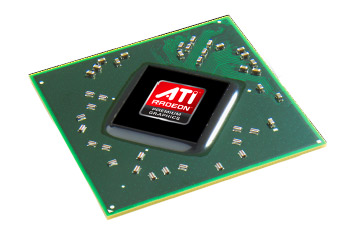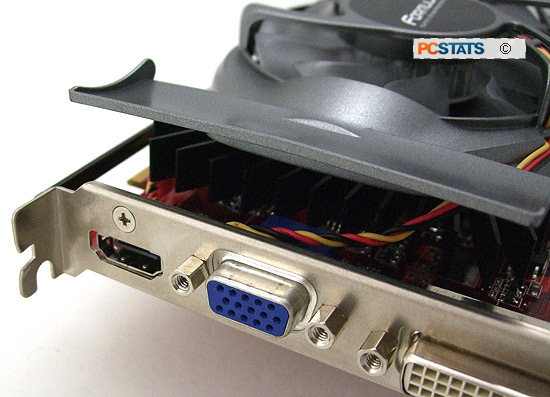The Radeon HD 4770 'RV740' GPU
is manufactured on a 40nm process, making it the first desktop GPU to be made
on such a small processing node.  The GPU
itself contains 826 million transistors, and total board power sits around
80W. Smaller manufacturing processes improve power efficiency and to some extent allows the GPU to be
clocked higher without the lock-step increase in heat. Another benefit is that videocard manufacturers can
produce more GPUs from the same silicon wafer, which lowers production costs and
keeps the videocard affordable.
The GPU
itself contains 826 million transistors, and total board power sits around
80W. Smaller manufacturing processes improve power efficiency and to some extent allows the GPU to be
clocked higher without the lock-step increase in heat. Another benefit is that videocard manufacturers can
produce more GPUs from the same silicon wafer, which lowers production costs and
keeps the videocard affordable.
To really
understand where the ATI Radeon HD 4770 (RV740) graphics card fit in, it's
best to compare it directly against several mainstream videocards. For
although the RV740 GPU is a direct descendent of the RV770 from ATI's flagship
Radeon HD 4870 and 4870 X2 graphics cards, much of the original card's complex
microarchitecture has been stripped down.
While the model numbers indicate that the Radeon HD 4770 is a series
"below" the Radeon HD 4850, the RV740 GPU is clocked at 750MHz, compared to 625MHz
for the Radeon HD 4850. The Radeon HD 4770 is paired with GDDR5 memory operating
at 800MHz (effective speed: 3200MHz), so it has a higher data rate than the
GDDR3 RAM used with Radeon HD 4850 cards.
|
Videocard
Comparison Chart
|
|
ATI
Radeon HD 4550 |
ATI Radeon HD
4770 |
ATI Radeon HD
4830 |
ATI Radeon HD
4850 |
NVIDIA Geforce GTS
250 |
| GPU Code Name: |
RV710 |
RV740 |
RV770 |
RV770 |
G92+ |
| GPU Process: |
55nm |
40nm |
55nm |
55nm |
55nm |
| GPU Transistors: |
242 Million |
826
Million |
956 Million |
956 Million |
754 Million |
| Board Power: |
25W |
80W |
110W |
110W |
150W |
| GPU Core Clock Speed: |
600MHz |
750MHz |
575MHz |
625MHz |
738MHz |
| Memory Speed: |
800MHz(1600MHz GDDR3) |
800MHz(3200MHz GDDR5) |
900MHz(1800MHz DDR) |
993MHz(1986MHz DDR) |
1100MHz(2200 DDR) |
| Memory Capacity: |
256MB |
512MB GDDR5 |
512MB GDDR3 |
512MB GDDR3
|
512MB GDDR3 |
| Memory bandwidth: |
12.8 GB/S |
51.2 GB/S |
57.6 GB/S |
63.5
GB/S |
70.4 GB/S |
| Stream Processors: |
80 |
640 |
640 |
800 |
128 |
| Texture units: |
8 |
32 |
32 |
40 |
64 |
| Raster Operators: |
4 |
16 |
16 |
16 |
16 |
| GFLOPS: |
96 |
960 |
736 |
1000 |
470 | | |
However
the Radeon 4850 GPU still has more robust architecture; 800 stream processors
and a 40 texture units compared to the HD 4770 which has 640 stream processors
and 32 texture units. Even the Radeon HD 4770's use of GDDR5 memory doesn't make
it a clear winner on specs alone, since it's limited to a 128-bit wide memory
bus, whereas the Radeon HD 4850 GDDR3 memory uses a 256-bit wide memory bus.
 What all this means is that the RV740 GPU isn't quite as
smart as the RV770 or NVIDIA's G92+, but it's not too far off.
What all this means is that the RV740 GPU isn't quite as
smart as the RV770 or NVIDIA's G92+, but it's not too far off.
The Radeon HD 4850 has more stream processors than the Radeon HD 4770
(800 vs 640), while the Geforce GTS250 makes use of more texture units and vertex
pipelines, which turns into greater shader processing and geometry rendering
power.
This means that games that feature complex special effects
like distortion, HDR lighting or reflections, or in games with especially
complex geometry, the Radeon HD 4770 videocard won't get quite as much done
each rendering pass, although it does boast compute performance of 960GFLOPs.
Altogether the Radeon HD 4770 will likely
process less shader information in a single pass than the Radeon HD 4850, but
compensate for that by running through each pass more
quickly. This should translate to very close benchmark results between the two cards in
shader-intensive games like Crysis, but there's no need to speculate. Before PCSTATS cuts
to the benchmarks and overclocking, it's time to see if Asus' new
manufacturing process has improved the EAH4770 FORMULA's power consumption numbers...
Videocard Power Draw Tests
Here's
how the Asus EAH4770 FORMULA videocard stacks up for power consumption in
real life against a couple different graphics cards. PCSTATS measures total
system power draw and compares that in 3D loaded (max value recorded in
3DMark06) and idle states (at Windows desktop). The power supply used in each
test is an A-PFC compliant PC Power and Cooling 750W model.
While Asus' re-design of the PCB does seem to have
increased the power draw of the EAH4770 FORMULA videocard by a tad, overall power consumption
is still well below most PCI Express videocards in its class. Total
system power draw is only 158W under load, meaning that even the lowliest of
power supplies should be able to handle this videocard. Seems that 40nm
GPU really pay's off!
With a
new cooler and some improved engineering, PCSTATS sets about overclocking the
Radeon HD 4770!
